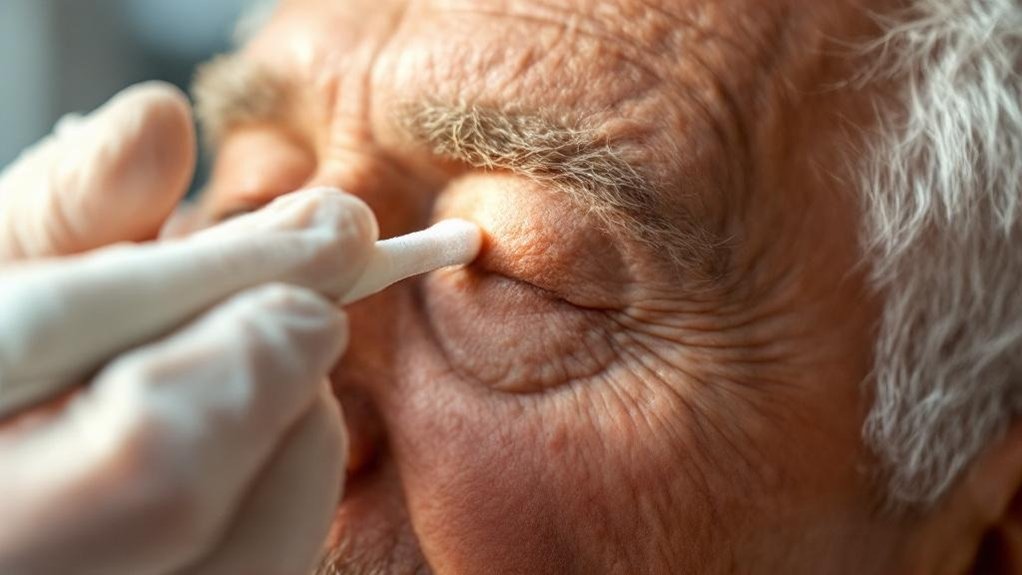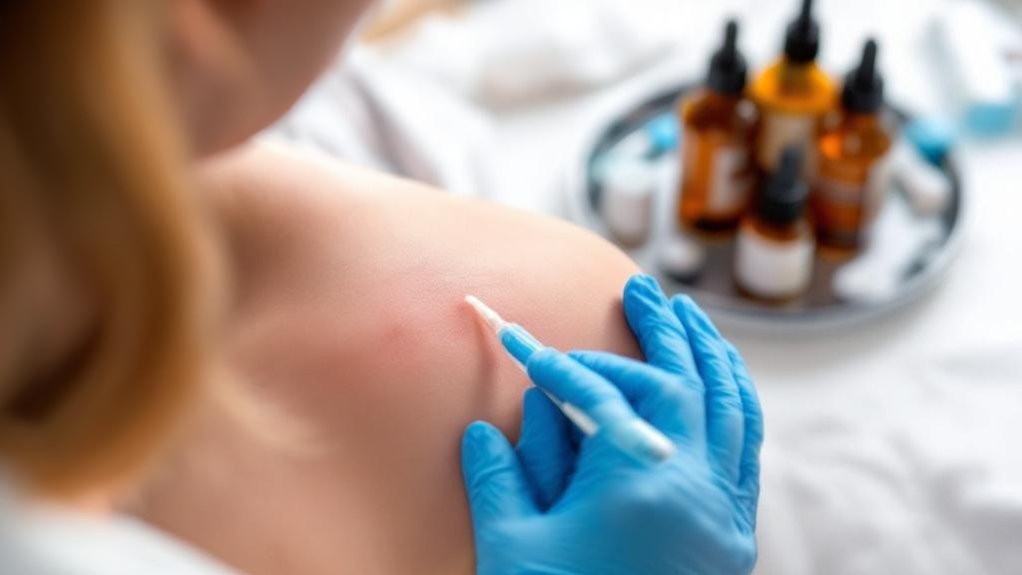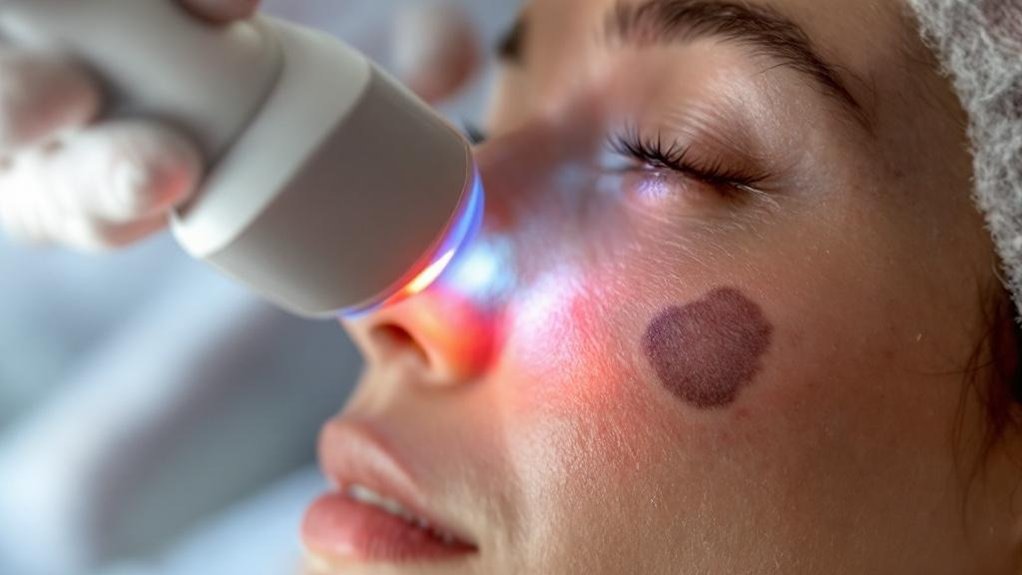Posted by: Skin And Cancer Institute in Medical Dermatology

Seborrheic keratosis can be removed non-surgically through several effective methods. We recommend beginning with professional treatments like cryotherapy, which freezes lesions using liquid nitrogen, or chemical peels containing TCA or glycolic acid. For persistent growths, laser therapy or intense pulsed light effectively targets multiple lesions with minimal downtime. While OTC products containing salicylic acid may temporarily reduce appearance, they seldom eliminate growths completely. Professional evaluation guarantees appropriate treatment selection for your specific condition.
Key Takeaways
- Cryotherapy freezes seborrheic keratosis with liquid nitrogen, causing lesions to blister and fall off within 1-2 weeks.
- Professional chemical peels using TCA or glycolic acid remove superficial layers of seborrheic keratosis over multiple sessions.
- Laser therapy with Erbium:YAG or CO2 lasers vaporizes resistant growths without damaging surrounding tissue.
- Prescription topical treatments containing retinoids or alpha-hydroxy acids can reduce appearance with consistent application.
- Microdermabrasion physically exfoliates smaller lesions and requires minimal downtime compared to surgical removal.
Understanding Seborrheic Keratosis: Causes and Identification

While seborrheic keratosis affects millions of Americans, these benign skin growths remain widely misunderstood. These warty, waxy lesions typically appear as tan, brown, or black growths that seem to be “stuck on” the skin’s surface.
Seborrheic keratoses develop due to several factors, with genetic predisposition playing a significant role. If your parents developed these growths, you’re more likely to experience them too.
Age is another contributing factor, as they commonly emerge after 50.
Skin pigmentation can influence how seborrheic keratoses present. They’re particularly noticeable on lighter skin tones but can affect all skin types.
Unlike moles or melanoma, these growths don’t usually change rapidly in appearance.
We recommend professional evaluation of any new skin growths to guarantee proper identification and treatment.
Our board-certified dermatologists at the Skin and Cancer Institute use advanced diagnostic imaging to ensure accurate assessment of seborrheic keratosis and other skin conditions.
Over-the-Counter Treatments and Home Remedies
Many patients inquire about over-the-counter options before pursuing professional treatment for seborrheic keratosis. While we recognize the appeal of home remedies, we must emphasize that most OTC products aren’t clinically proven effective for completely removing these lesions.
Some patients report temporary improvement using products containing salicylic acid or alpha hydroxy acids, which may help reduce the appearance of smaller lesions.
Diet modifications focusing on antioxidant-rich foods might support overall skin health but won’t directly eliminate seborrheic keratosis.
Consistent skincare routines using gentle exfoliation and moisturization may help manage the appearance of these growths.
However, it’s noteworthy that seborrheic keratosis typically requires professional evaluation and treatment for effective removal, especially for larger or suspicious-looking growths.
For comprehensive treatment options, our board-certified dermatologists at Skin and Cancer Institute specialize in various skin conditions and can develop personalized treatment plans.
Professional Topical Solutions and Chemical Peels

Professional treatment options for seborrheic keratosis have expanded beyond surgical interventions to include effective topical solutions and chemical peels.
At our practice, we offer prescription-strength compounds containing alpha-hydroxy acids or retinoids that gradually diminish these growths over several applications.
Steroid creams may be recommended to reduce inflammation and itching associated with irritated lesions, particularly in sensitive areas.
For more prominent growths, we perform controlled chemical peels using trichloroacetic acid (TCA) or glycolic acid that effectively remove the superficial layers where seborrheic keratoses reside.
Many patients also benefit from microdermabrasion techniques, which physically exfoliate the skin’s surface to reduce the appearance of smaller lesions.
These professional treatments typically require multiple sessions but offer excellent outcomes with minimal downtime compared to surgical alternatives.
Like modern body sculpting techniques, these treatments prioritize effectiveness while minimizing recovery time and discomfort.
Cryotherapy and Freezing Techniques
Among our most effective non-surgical interventions, cryotherapy stands out as a quick and reliable method for removing seborrheic keratosis lesions. This technique involves precise cold application to the affected area, typically using liquid nitrogen at temperatures below -196°C.
During the procedure, our dermatologists carefully target each lesion with a controlled spray or cotton-tipped applicator. The extreme cold destroys abnormal cells while preserving surrounding healthy tissue.
Patients may experience a brief stinging sensation followed by redness and mild swelling.
The treated lesion typically forms a blister, crusts over, and falls off within 1-2 weeks. Most cases require just one treatment, though larger or thicker lesions might need follow-up sessions.
We’re pleased to offer this minimally invasive option that delivers excellent cosmetic results with minimal downtime.
Our board-certified dermatologists at the Skin and Cancer Institute in Mesquite, NV have extensive experience providing this treatment with Medicare coverage for eligible patients.
Laser and Light Therapy Options for Persistent Lesions

While cryotherapy offers excellent results for most seborrheic keratosis cases, some lesions prove resistant to freezing techniques.
For these persistent growths, we offer advanced laser dermatology and light-based therapy options at our practice.
Our dermatologists utilize erbium:YAG or CO2 lasers that precisely target and vaporize the abnormal skin cells without damaging surrounding tissue.
Light-based therapy, including intense pulsed light (IPL), can effectively treat multiple lesions simultaneously, especially in patients with numerous seborrheic keratoses.
These sophisticated treatments typically require minimal downtime, with most patients experiencing only mild redness for a few days post-procedure.
We’ll evaluate your specific skin condition to determine if laser or light therapy represents the most suitable approach for your resistant lesions.
Many patients appreciate these non-surgical alternatives that provide excellent cosmetic outcomes.
Consulting a board-certified dermatologist ensures accurate diagnosis and prevents potential misidentification with other similar-appearing skin conditions.
Frequently Asked Questions
Will My Insurance Cover Seborrheic Keratosis Removal Treatments?
Insurance coverage depends on your specific plan. We recommend checking with your provider about treatment affordability for seborrheic keratosis removal, as many insurance companies consider it cosmetic.
How Soon Can I Resume Normal Activities After Treatment?
Most patients resume normal activities immediately after treatment. Downtime expectations vary by method used, but are typically minimal. We recommend gentle skincare and sun protection during recovery for ideal results.
Are There Any Age Restrictions for These Treatments?
We generally have no strict age restrictions for seborrheic keratosis treatments. We consider each patient’s overall health and skin condition when evaluating treatment safety. Age considerations are part of our thorough assessment process.
Can Seborrheic Keratosis Return After Successful Removal?
Yes, seborrheic keratosis can recur after removal. We find the recurrence risk is relatively low when properly treated, though new lesions may develop elsewhere. Long-term outcomes are generally excellent for our patients.
How Do I Choose the Right Treatment Option for Me?
We’ll help you select the most suitable treatment method based on your lesion size, location, and skin type. Your preference for healing time and cosmetic outcome will guide our recommendation.
Conclusion
We’ve outlined multiple non-surgical approaches for seborrheic keratosis removal that offer excellent alternatives to excision. From topical treatments to advanced laser therapies, these options provide effective results with minimal downtime. When you’re concerned about these benign growths, we’ll help determine which method best suits your specific case, skin type, and location of lesions. Contact our dermatology team to discuss the most appropriate non-surgical solution for your needs.